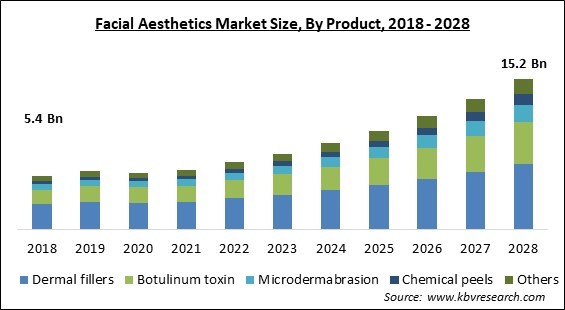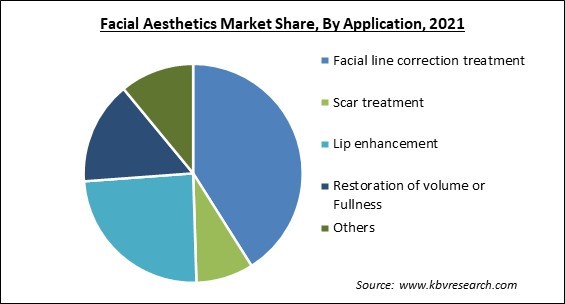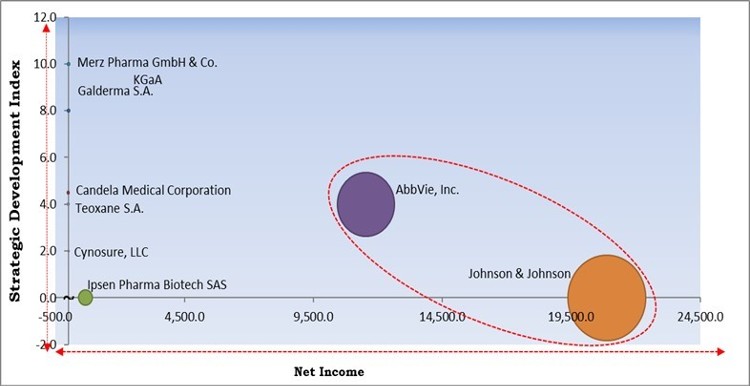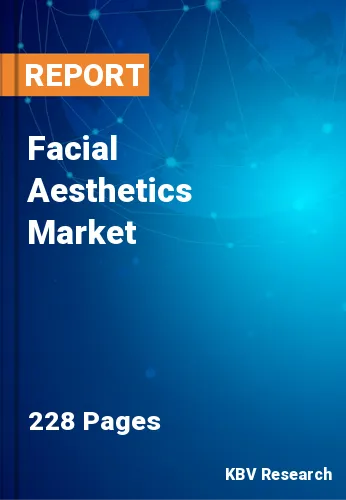The Global Facial Aesthetics Market size is expected to reach $15.2 billion by 2028, rising at a market growth of 14.5% CAGR during the forecast period.
Facial aesthetics, also known as facial cosmetic surgeries, are non-surgical operations intended to reduce the appearance of age-related changes in the skin. Dermal fillers and Botox injections are the most common type of ailments used in facial aesthetics. They can be applied to practically any part of the body, but the face, neck, and shoulders are where they are most frequently utilized.
Excessive perspiration, pigmentation removal, the treatment of acne, scars, skin tags, and moles, as well as enhancement of vein look, are other conditions that can be addressed with aesthetic procedures. Botulinum toxin is most frequently used to treat wrinkles on the forehead, between the brows, and around the eyes.

Fillers can be applied to the lips, cheeks, nose-to-mouth lines, and below-the-mouth lines, but they can also be used in place of or in addition to botulinum toxin within the same regions of the face. Different kinds and sizes of molecules can be used to treat various conditions, and an evaluation enables surgeons to choose the kind that is best for the patient.
Treatments for facial aesthetics have the potential to offer significant advantages without surgery. Non-surgical cosmetic procedures that draw attention to a patient's characteristics and enhance their natural beauty are included in facial aesthetics. These procedures, which frequently involve the use of Botox or Fillers, aim to smooth out wrinkles and clarify facial features while also reviving and rejuvenating the skin.
Facial aesthetics also make the skin look and feel healthier. Fighting indications of aging, creating facial symmetry, and tightening wrinkled and drooping skin. Both men and women can choose from a variety of facial aesthetic procedures to project an image that increases their self-assurance and comfort with their appearance.
The manufacturing and supply chain for the luxury and beauty industries faced a number of hurdles, like lack of timely product delivery to customers and uneven demand for goods and services. The market also witnessed a brief period of negative growth, which can be attributed to a number of factors, including a decline in product demand from major end users, limited operations in the majority of industries, the temporary closure of major end-user facilities (such as beauty salons and spas), a disrupted supply chain, and difficulties in providing necessary/post-sales services because of the lockdown.
The quantity and proportion of aging people in the world's populations are growing, which is a global phenomenon known as population aging. According to the United Nations Organization, I n 2019, there was approximately 703 million people worldwide who were 65 or older. In 2050, it is expected that there will be 1.5 billion senior people. In the entire world, the percentage of people 65 and older rose from 6% in 1990 to 9% in 2019. By 2050, the number is estimated to reach 16%, meaning that 1 in 6 individual all over the world would be 65 years of age or older. The majority of the world's population is also witnessing an extended life expectancy.
One of the major factors that are driving the growth of the facial aesthetics market is that it is a very minimally invasive surgery. Among the most popular non-invasive rejuvenation methods, chemical peels, injectable botulinum toxin, and soft-tissue fillers are all useful for improving the appearance of the face. For the diagnosis and treatment of a variety of ailments that formerly required sternotomy or open surgeries, minimally invasive surgery is an excellent strategy.
Facial aesthetics has the potential to produce severe adverse effects, despite the fact that it is normally considered to be safe when used within a clinical setting. Most typically, the injection can be injected into the wrong muscle group, or over time, it might spread from the injection site and temporarily paralyze undesirable muscles. The primary cause of the negative effects of cosmetic use is unintentional paralysis of the facial muscles. These include trouble swallowing, weakened muscles, and partial paralysis of the face.
By Product, the Facial Aesthetics Market is segregated into Dermal fillers, Botulinum toxin, Microdermabrasion, Chemical peels, and Others. In 2021, the dermal fillers segment acquired the largest revenue share of the facial aesthetics market. The rising growth of the segment is primarily owing to the changing habits and lifestyles of people all over the world. A significant number of people all over the world do smoke regularly.

On the basis of Application, the Facial Aesthetics Market is segmented into Facial line correction treatment, Scar treatment, Lip enhancement, Restoration of volume or Fullness, and Others. In 2021, the lip enhancement segment registered a substantial revenue share of the facial aesthetics market. The method of lip augmentation that is most frequently utilized nowadays is an injected dermal filler. Dermal fillers come in a variety of forms that can be injected into the lips and the area surrounding the mouth.
Based on End-User, the Facial Aesthetics Market is classified into Specialty and Dermatology Clinics, Hospitals, and Others. In 2021, the hospitals segment witnessed the highest revenue share of the facial aesthetics market. Due to an increase in hospitals performing facial aesthetic procedures and rising government spending to upgrade hospital aesthetic centers, the growth of this segment is accelerated.
| Report Attribute | Details |
|---|---|
| Market size value in 2021 | USD 6 Billion |
| Market size forecast in 2028 | USD 15.2 Billion |
| Base Year | 2021 |
| Historical Period | 2018 to 2020 |
| Forecast Period | 2022 to 2028 |
| Revenue Growth Rate | CAGR of 14.5% from 2022 to 2028 |
| Number of Pages | 228 |
| Number of Tables | 395 |
| Report coverage | Market Trends, Revenue Estimation and Forecast, Segmentation Analysis, Regional and Country Breakdown, Competitive Landscape, Companies Strategic Developments, Company Profiling |
| Segments covered | Product, Application, End User, Region |
| Country scope | US, Canada, Mexico, Germany, UK, France, Russia, Spain, Italy, China, Japan, India, South Korea, Singapore, Malaysia, Brazil, Argentina, UAE, Saudi Arabia, South Africa, Nigeria |
| Growth Drivers |
|
| Restraints |
|
Region-Wise, the Facial Aesthetics Market is analyzed across North America, Europe, Asia-pacific, and LAMEA. In 2021, North America accounted for the largest revenue share of the facial aesthetics market. The surging growth of the regional market is attributed to an increase in botulinum toxin procedures, a rise in the number of facial aesthetics product approvals, the existence of the facial aesthetics industry, and improvements in the medical and aesthetic sectors in the area are all credited with this.
Free Valuable Insights: Global Facial Aesthetics Market size to reach USD 15.2 Billion by 2028

The major strategies followed by the market participants are Product Launches. Based on the Analysis presented in the Cardinal matrix; AbbVie, Inc. and Johnson & Johnson are the forerunners in the Facial Aesthetics Market. Companies such as Merz Pharma GmbH & Co. KGaA, Galderma S.A. and Candela Medical Corporation are some of the key innovators in Facial Aesthetics Market.
The market research report covers the analysis of key stake holders of the market. Key companies profiled in the report include AbbVie, Inc., Merz Pharma GmbH & Co. KGaA, Galderma S.A., Candela Medical Corporation (Syneron Medical Ltd.), Teoxane S.A., Johnson & Johnson, Cynosure, LLC, Bausch Health Companies, Inc., Ipsen Pharma Biotech SAS, and Fotona D.o.o.
By Product
By Application
By End User
By Geography
The global Facial Aesthetics Market size is expected to reach $15.2 billion by 2028.
Expansion Of The Geriatric Population All Over The World are driving the market in coming years, however, Side Effects Of The Toxins Used In Facial Aesthetics restraints the growth of the market.
AbbVie, Inc., Merz Pharma GmbH & Co. KGaA, Galderma S.A., Candela Medical Corporation (Syneron Medical Ltd.), Teoxane S.A., Johnson & Johnson, Cynosure, LLC, Bausch Health Companies, Inc., Ipsen Pharma Biotech SAS, and Fotona D.o.o.
The expected CAGR of the Facial Aesthetics Market is 14.5% from 2022 to 2028.
The Facial line correction treatment segment acquired maximum revenue share in the Global Facial Aesthetics Market by Application in 2021 thereby, achieving a market value of $6 billion by 2028.
The North America market dominated the Global Facial Aesthetics Market by Region in 2021, and would continue to be a dominant market till 2028; thereby, achieving a market value of $5.6 billion by 2028.
Our team of dedicated experts can provide you with attractive expansion opportunities for your business.

